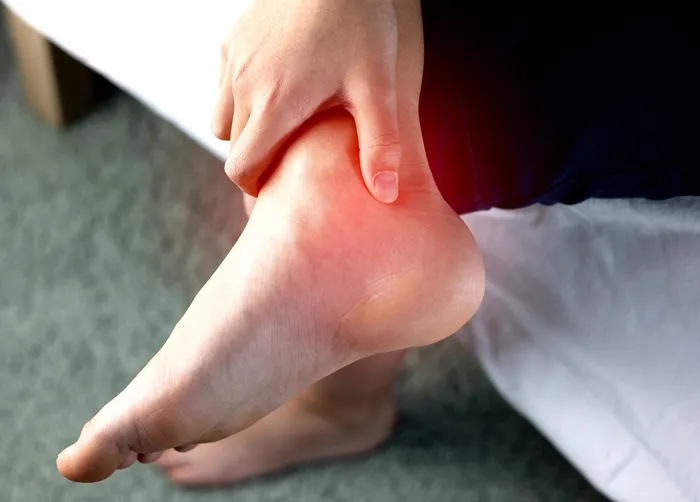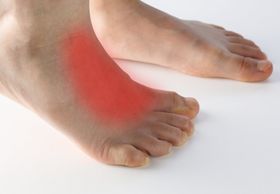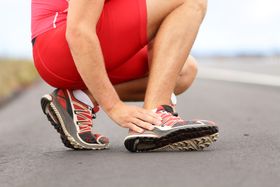Potential Causes and Diagnosis of Pain at the Back of the Heel
Updated January 24, 2024.

Heel pain is a common cause of discomfort in many people. It’s a symptom with a diverse number of causes ranging from those that affect the heel bone directly to those that affect structures around it. One of the most commonly affected areas of the heel is the back.
Heel pain can make it difficult to perform your activities of daily living. For treatment to be effective, a proper diagnosis is necessary. Where treatment is prompt, the pain can be limited and the condition controlled by non-surgical treatments. Otherwise, surgery may be necessary.
Let’s consider in some more detail what pain in the back of the heel look like and its causes.
Areas of Pain in Heel
The area where pain occurs in the heel can indicate its case. Generally, there are three patterns to the presentation of pain in the heel:
- Behind the heel
- Under the heel
- Within the heel bone
Symptoms of Heel Pain
Alongside heel pain, you can expect the following symptoms:
- Skin discoloration (bruising or redness)
- Warmth around the tendon
- Achilles tendon tightness
- Ankle joint stiffness
- Swelling and tenderness
- Pain on standing from a resting/sitting position
Causes of Pain in the Heel
As previously mentioned, heel pain can have several different causes, the most common of which are as follows:
- Achilles tendonitis This is the major cause of pain at the back of the heel. It occurs when the Achilles tendon becomes inflamed due to overuse and is more common in men and older people.
- Plantar fasciitis Plantar fasciitis causes pain at the bottom of the heel. It occurs when excessive loading of the feet damages the plantar fascia ligament, leading to inflammation and stiffness. It is most common in people that engage in high-impact activities like running.
- Heel bursitis This is an inflammation of the bursae between your heel bone and Achilles tendon, causing pain in the back of the heel bone.
- Stress fractures A sudden increase in intensity by athletes over a short period can lead to a stress fracture of the heel bone.
- Heel pad bruise This is caused by an acute traumatic injury to the back of the heel leading to sharp pain. It can be caused by excessive weight-bearing exercises and landing poorly after jumping from a high perch.
- Fat pad atrophy With aging, the fat pad in the heel of atrophies. Likewise, the thinning of the fat pad can occur with repeated trauma to the heel (for example, the heel of an obese person or marathon runner). The result is an aching pain in the bottom and back of the heel.
Factors That Increase the Risk of Heel Pain
Generally, the chance of developing heel pain increases with more pressure and loading on the feet. Thus, you’re more likely to develop heel pain if you:
- Are obese
- Perform high-impact activities like running or jumping often
- Have flat feet or high foot arches
- Have foot and ankle arthritis
- Stand for long periods at a time on hard surfaces
- Wear ill-fitting shoes without proper support or cushioning
- Have a history of injury around the heel
How Can You Treat Heel Pain?
Pain in the back of the heel is generally amenable to non-conservative treatment, such as the following methods:
- Rest
- Medication Use of non-steroidal anti-inflammatory drugs (NSAIDs) can reduce inflammation and relieve pain.
- Ice Cold treatment can address pain and inflammation.
- Less activity Activity modification so that the foot bears less load can reduce strain.
- Corticosteroid injections Cortisone (steroid) injections can ease pain and swelling.
- Physical therapy This will incorporate exercises (mobilization, strengthening, stretching), massage, ultrasound, and several other physiotherapy techniques. Physiotherapy intervention aims to stretch the tendon, strengthen the foot muscles, and relieve pain.
- Alignment correction Taping and splinting can relieve pain and stretch the foot, respectively.
- Orthotic devices Orthotics are useful in relieving pain at the back of the heel bone. Compared to OTC inserts, custom orthotics are more useful in this regard. Upstep provides custom-made orthotics that support the ankle and relieve pain.
- Proper footwear Wearing appropriate shoes and insoles that are properly fitting, cushioned, and have heel lifts reduces stress on the Achilles tendon.
Should You Call Your Doctor?
It’s okay to first try some of the home remedies discussed above when you first notice heel pain. However, if pain persists after a few weeks of treatment, you must consult a doctor promptly.
Your doctor will help you determine the location of the pain in your heel and identify the likeliest cause. Treatment is much easier once there is an accurate diagnosis. Otherwise, it can lead to untold complications.








